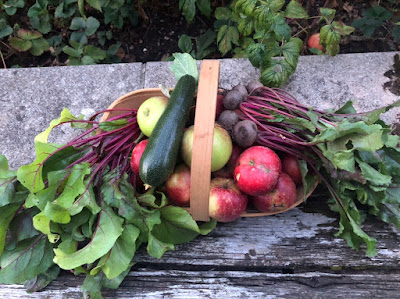These are questions I'm asking myself: Have you gathered and bagged up leaves? Emptied the compost bin? Mulched your borders? Cleared the summer veg beds? Started off garlic cloves? Planted pots for a bit of winter pizazz? Pruned the roses? Given the hedge a last trim? Got all those spring bulbs planted? Yes? Ah, maybe that's just me falling behind then. Time to get busy!
I regret not making the most of the gorgeously warm start to autumn now normal service has resumed - damp foggy mornings and dropping temperatures ... but the golden hues of trees heading towards their winter hibernation and shrubs dripping with berries is a trade off I can live with.
During the day I garden for other people so my own garden goes to the back of the queue - see list above and the reason why I still have bulbs to plant - tulips, snowdrops, leucojum, fritillaries and iris reticulata; I can't resist buying them and adding to my pots and borders. November is a good time to get bulbs in the ground before the soil (and air!) becomes noticeably colder. So that's got to be one of the first tasks on my list of self-perpetuating garden work.
This month is also good for dividing perennials and moving plants. I've a chunk of rhubarb to move and have also promised to dig up some of my hellebores for a lovely 90 year old for her garden. Last year I took round a few of my self seeded forget-me-nots; they flowered frothily in spring and have spread prolifically. I've relocated a few clumps to create flower drifts across her borders ... just dig them up with a good root ball attached and replant straight away into the new position.
Beetroot have been roasted, eaten, made into chutney or delicious muffins (my thanks to Karen for the recipe; my waistline applauds you!) or frozen. Yes, frozen - who knew that was even possible! Well, I do now. (Cooked, peeled, sliced for ease of defrosting, and laid out on a tray to flash freeze before being bagged up, labelled and frozen for up to 6 months.)
Carrots. I was gifted seeds from Premier Seeds in Poland to try. By summer's end, the roots were still frustratingly small but tasty so I left them to grow on a bit. By the end of October, after a warm and wet month, the roots were fat, large, and delicious. Those seeds will definitely go on my list for late autumn veg next year!
My apples have mostly been windfalls, but nothing has been wasted. The bruises and wildlife munchings have been chopped out and the good bits made into utterly delicious Spiced Apple Butter or stewed for the freezer. Fruit butters are a thickened spiced purée - a spread I hadn't come across before which has now introduced me to a whole new world of toasty deliciousness!
November in the garden. I will ...
- Cut autumn fruiting raspberry canes down to a few inches above the soil once the leaves have all dropped. Mulch the soil to feed the canes once done. The fruit was not good this year; hoping for better next.
- Stake and mulch around broccoli plants - they get big and hungry!
- Gather leaves for leaf mulch. A large black bag with air holes punched in will do but any large container that lets water and air in and out will do; leave for a year or two.
- Plant garlic cloves
- Divide rhubarb and replant divisions. Mulch around the crowns.
- Sow Aquadulce or Sutton broad beans (these are winter hardy types), sweet peas
- Plant spring bulbs!
- Start to prune apple, pear and quince trees for shape and to cut away dead, diseased or crossing branches
- Empty the compost bin (My least favourite job!)
- Put out bird feeders or check food levels in existing feeders.
Next in my client gardens I'll be pruning back untidy shrubs (but not those that flower in spring!), relocating a rose bush that's outgrown its space, planting bare root roses (perfect time for this!) and reducing other roses by up to a third to avoid wind rock to the roots. There's also still time to plant up some large pots for a bit of winter colour.
If you've enjoyed reading this, come back for more inspiration for edible and colourful winter pots!
The preserving books I refer to:
- National Trust Complete Jams, Preserves and Chutneys - for apple butter. Windfall Chutney and the best blackberry and apple jam.
- The Modern Preserver, Kylee Newton - for Tomato Kasundi and Beetroot & Orange Chutney
- Gardener Cook, Christopher Lloyd - for Old Fashioned Quince Pudding and other quince recipes.















